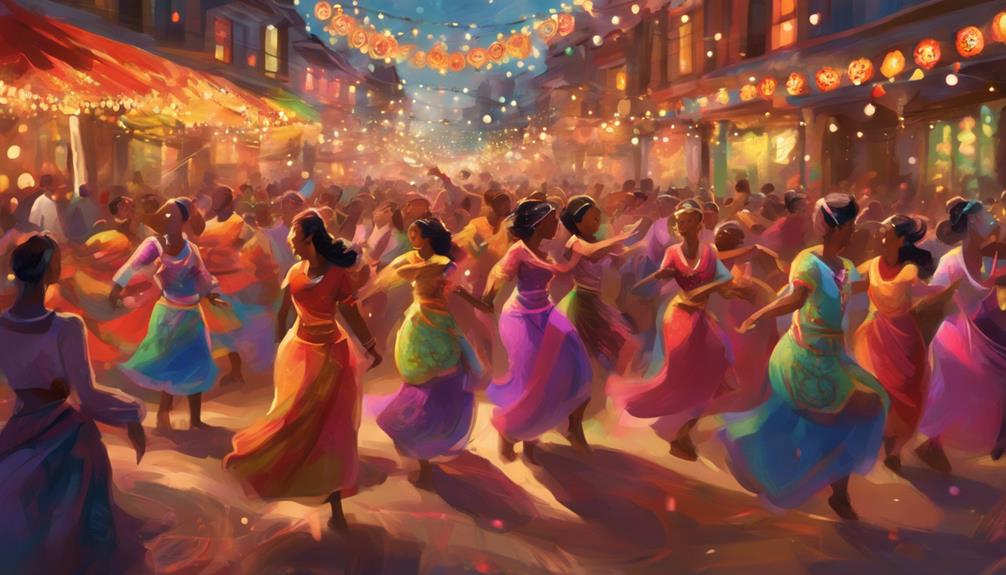When you describe a festivity, you're painting a vivid picture that transports others to a vibrant atmosphere of joy, excitement, and connection. You're setting the scene with twinkling lights, festive decorations, and infectious energy. Every sensory detail counts – from the sounds of lively music and joyful chatter to the aromas of delicious food and sweet treats. You're capturing emotions and energy, showcasing cultural significance, and using vivid language to bring the celebration to life. By incorporating storytelling techniques and engaging the audience, you'll create an immersive experience that leaves a lasting impression – and there's more to explore.
Key Takeaways
- Describe the setting and atmosphere, including decorations, lighting, and sensory experiences.
- Highlight emotional and social connections, such as joy, nostalgia, and community bonding.
- Emphasize cultural significance and heritage, including historical context and traditions.
- Use vivid and descriptive language, including metaphors, similes, and sensory details.
Setting the Festive Scene
As you step into the festive scene, you're immediately enveloped in a prism of colors, sounds, and aromas that transport you to a world of joy and celebration.
The festive atmosphere is electric, with vibrant decorations and twinkling lights that create a joyful ambiance. You can't help but feel a sense of excitement and wonder as you take in the sights and sounds around you.
The air is filled with the sweet scent of festive treats and the sound of laughter and music. As you look around, you notice the attention to detail that has gone into creating this special atmosphere.
Every element, from the colorful balloons to the festive table settings, has been carefully crafted to create a truly unforgettable experience. The result is a space that's full of energy and joy.
Describing Sensory Experiences
As you transport your readers to the festive scene, you'll want to engage their senses, drawing them in with the sights, sounds, smells, tastes, and textures that make the celebration come alive.
To effectively describe sensory experiences, consider the distinctive sounds that fill the air, like the joyful chatter of attendees or the lively music that gets everyone on their feet.
Sounds of Celebration
You're immediately enveloped in the vibrant atmosphere of the festivity as the air is filled with the sounds of laughter, chatter, and music, creating an infectious energy that draws you in and makes you want to join in on the celebration.
The music choices are eclectic, ranging from traditional folk tunes to modern pop hits, each one carefully selected to keep the party going. The rhythmic patterns are catchy and upbeat, making it impossible to resist the urge to dance.
As you move through the crowd, you're surrounded by the sounds of clinking glasses, cheering, and applause, all blending together to create a joyful cacophony that's quintessentially festive.
Every sound combines to create an unforgettable experience that will leave you grinning from ear to ear.
Smells of Delight
The aroma of sizzling delicacies wafts through the air, teasing your senses and drawing you in with the promise of a culinary adventure, as the scent of sweet treats and flavorful spices mingles with the smell of freshly brewed coffee and exotic teas.
You're enveloped in a world of festive fragrances, evoking aromatic memories of past celebrations. The pungency of grilled meats and the earthy sweetness of baked goods fill the air, tempting your taste buds.
Every sniff is a journey through a medley of flavors, as if your nose is conducting an orchestra of scents. Your stomach growls in anticipation as your senses relish the enticing smells.
In this whirlwind of fragrances, every note combines in harmony to create a rich, immersive experience, igniting a hunger that craves to be satiated.
Tastes of Tradition
Flavors of heritage unfold on your palate, where each bite transports you to a rich fabric of traditions, woven from threads of love, culture, and history. As you relish festive recipes, you're not just tasting food, you're experiencing the culinary heritage of a community. The aromas, textures, and flavors all blend together to create a sensory experience that's both personal and collective.
Here are some ways to describe the tastes of tradition:
- Heirloom ingredients: Emphasize the use of traditional ingredients, such as family-grown herbs or locally-sourced spices.
- Time-honored techniques: Highlight the cooking methods that have been passed down through generations, like slow-cooking or wood-fired roasting.
- Cultural influences: Note the diverse cultural influences that have shaped the festive recipes, such as African, Asian, or Latin American flavors.
- Emotional connections: Share the emotional connections that people have with these traditional dishes, like nostalgia or a sense of belonging.
Capturing Emotions and Energy
As you engage yourself in the festivity, it's essential to capture the emotions and energy that pulse through the air, a dynamic fusion of sounds, scents, and sensations that can leave you breathless and yearning for more.
You notice the joyful expressions on people's faces, their smiles and laughter contagious, as they revel in the communal spirit. Strangers become friends, united by the shared experience.
The atmosphere is electric, with music and chatter filling the air. You feel the excitement build, as everyone comes together to celebrate.
It's a moment of pure connection, where individuality dissolves into a collective joy. As you envelop yourself in the festivity, you're swept up in a wave of elation, your senses heightened, and your spirit lifted.
Using Vivid and Descriptive Language
Immersing yourself in the vibrant fabric of the festivity, you'll want to use vivid and descriptive language to bring the experience to life, drawing the reader into the mosaic of colors, textures, and sensations that swirl around you.
To create a rich and immersive description, try incorporating these techniques:
- Sensory details: Describe the sights, sounds, smells, tastes, and textures that surround you, using festive vocabulary to evoke a sense of excitement and joy.
- Vivid metaphors: Use creative comparisons to describe the festivities, such as 'a prism of colors' or 'a symphony of sounds'.
- Descriptive imagery: Paint a picture with words, using phrases like 'twinkling lights' or 'swirling patterns' to bring the scene to life.
- Emotive language: Use words that evoke emotions, such as 'exuberant', 'joyful', or 'magical', to convey the atmosphere of the festivity.
Showcasing Cultural Significance
You're likely aware that the cultural significance of a festivity extends far beyond the superficial displays of celebration, delving deep into the historical and social fabric that has woven it into being.
As you describe a festivity, you're not just painting a picture of colorful decorations and lively music, but also showcasing the cultural heritage that has been passed down through generations.
This heritage is often deeply rooted in community bonding, where people come together to share in the joy and spirit of the celebration.
Incorporating Storytelling Techniques
When describing a festivity, incorporating storytelling techniques can help bring the celebration to life, allowing readers to experience the sights, sounds, and emotions of the event firsthand. You can use storytelling elements to weave a narrative that transports readers to the heart of the festivity. This can be achieved by highlighting the people, their experiences, and the emotions that make the celebration special.
Here are some ways to incorporate storytelling techniques:
- Focus on the emotional connection: Share the stories of individuals who participate in the festivity, highlighting their personal experiences and emotions.
- Use vivid descriptions: Paint a picture with words that evoke the senses, drawing readers into the festive atmosphere.
- Highlight festive traditions: Share the history and significance of the festivity's customs and rituals.
- Create a sense of anticipation: Build excitement by describing the preparations and expectations leading up to the celebration.
Painting a Picture With Words
To paint a picture with words that effectively captures the essence of a festivity, it's helpful to think about the sensory details that make the celebration come alive, and then use descriptive language to convey those sensations to your readers.
You can start by incorporating metaphorical expressions that evoke the sights, sounds, and smells of the festivity. For example, you might describe the 'sea of colorful costumes' or the 'symphony of laughter and music' that fills the air.
Using festive imagery, you can transport your readers to the heart of the celebration, making them feel like they're right there with you.
Conclusion
As you vividly bring a festivity to life, you've got your audience entranced.
The sensory experiences are dancing on the page, transporting readers to the midst of the celebration.
Your use of emotive language captures the joy and excitement, and your incorporation of storytelling techniques adds a richness that engages them even further.
Your vivid descriptions and cultural nuances come together in perfect harmony, creating an unforgettable snapshot that readers can cherish forever.



